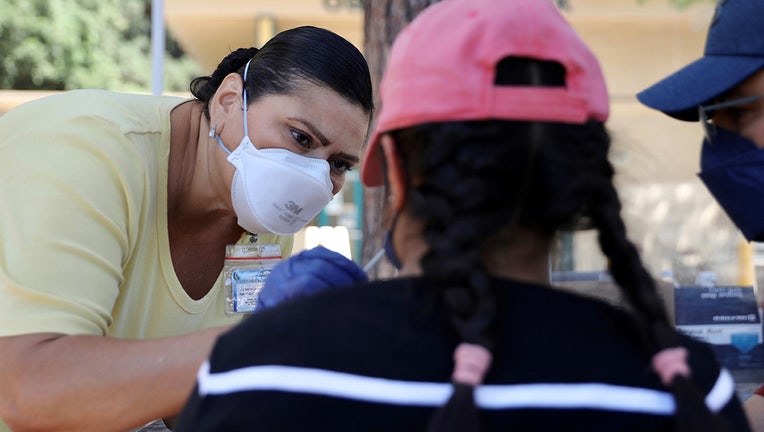CDC drops quarantine, screening recommendations for COVID-19

A medical worker collects a swab sample from a resident for a COVID-19 test in Los Angeles, California, the United States, on Aug. 5, 2022. (Photo by Xinhua via Getty Images)
NEW YORK - The nation's top public health agency on Thursday relaxed its COVID-19 guidelines, dropping the recommendation that Americans quarantine themselves if they come into close contact with an infected person.
The Centers for Disease Control and Prevention also said people no longer need to stay at least 6 feet away from others.
The changes are driven by a recognition that — more than 2 1/2 years since the start of the pandemic — an estimated 95% of Americans 16 and older have acquired some level of immunity, either from being vaccinated or infected, agency officials said.
"The current conditions of this pandemic are very different from those of the last two years," said the CDC's Greta Massetti, an author of the guidelines.
The CDC recommendations apply to everyone in the U.S., but the changes could be particularly important for schools, which resume classes this month in many parts of the country.
RELATED: New ‘Centaurus’ coronavirus variant surfacing in multiple countries
Perhaps the biggest education-related change is the end of the recommendation that schools do routine daily testing, although that practice can be reinstated in certain situations during a surge in infections, officials said.
The CDC also dropped a "test-to-stay" recommendation, which said students exposed to COVID-19 could regularly test — instead of quarantining at home — to keep attending school. With no quarantine recommendation anymore, the testing option disappeared too.
Masks continue to be recommended only in areas where community transmission is deemed high, or if a person is considered at high risk of severe illness.
School districts across the U.S. have been scaling back their COVID-19 precautions in recent weeks even before the CDC relaxed its guidance.
Masks will be optional in most school districts when classes resume this fall, and some of the nation’s largest districts have dialed back or eliminated COVID-19 testing requirements.
PREVIOUS: CDC endorses more traditional Novavax COVID-19 vaccine for adults
Some have also been moving away from test-to-stay programs that became unmanageable during surges of the omicron variant last school year. With so many new infections among students and staff, many schools struggled to track and test their close contacts, leading to a temporary return to remote classes in some places.
The average numbers of reported COVID-19 cases and deaths have been relatively flat this summer, at around 100,000 cases a day and 300 to 400 deaths.
The CDC previously said that if people who are not up to date on their COVID-19 vaccinations come into close contact with a person who tests positive, they should stay home for at least five days. Now the agency says quarantining at home is not necessary, but it urges those people to wear a high-quality mask for 10 days and get tested after five.
The agency continues to say that people who test positive should isolate from others for at least five days, regardless of whether they were vaccinated. CDC officials advise that people can end isolation if they are fever-free for 24 hours without the use of medication and they are without symptoms or the symptoms are improving.

